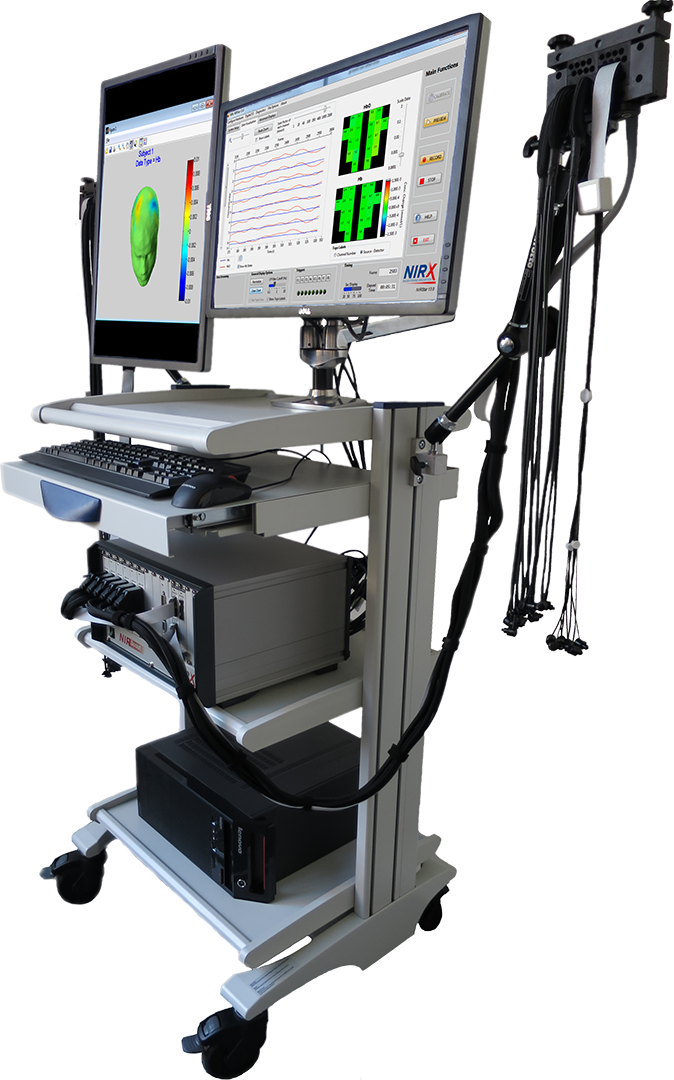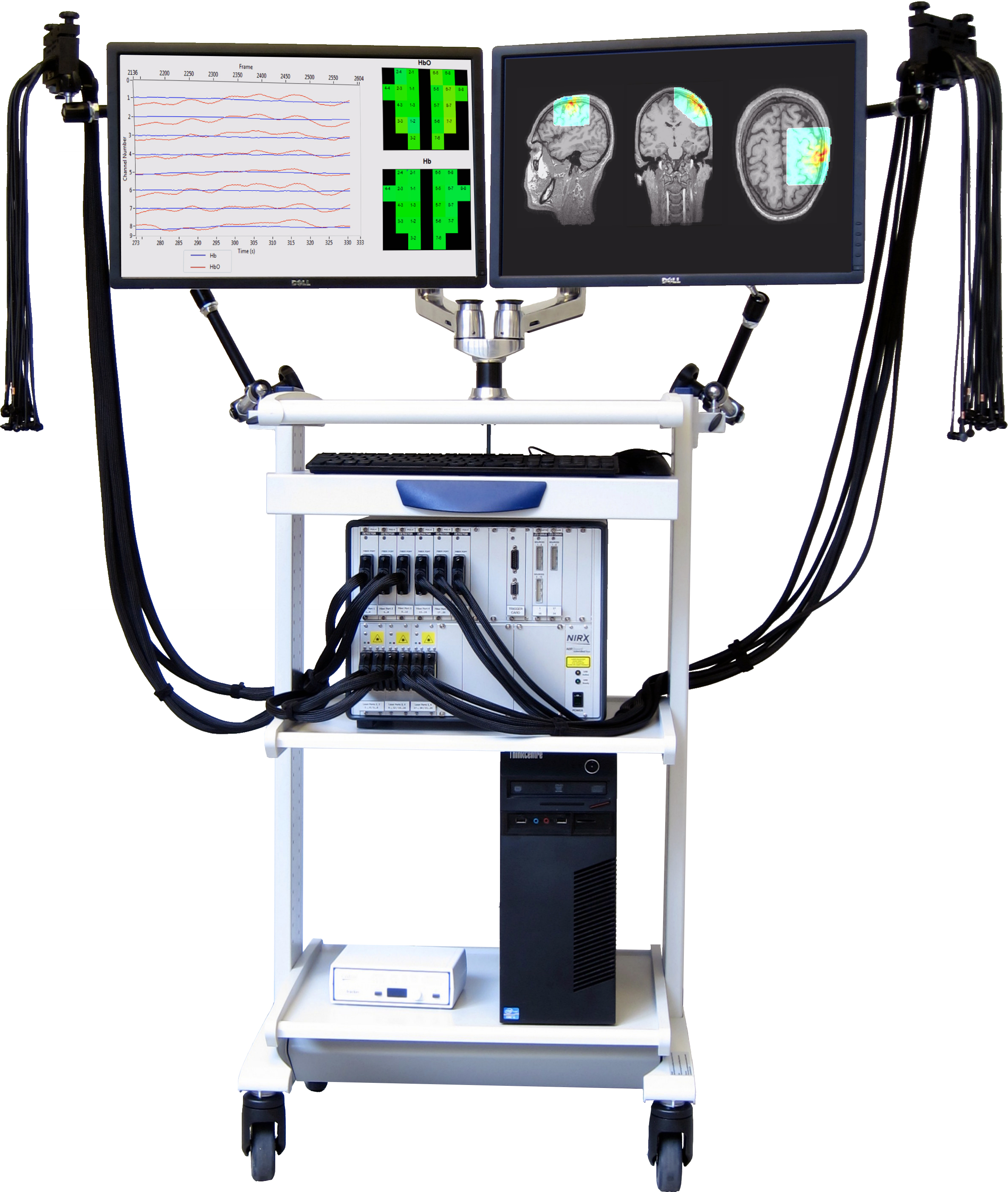Our most powerful and versatile lab-based fNIRS platform
The NIRScout system is the most versatile fNIRS research platform. It can scale from 4 source and 8 detector to 64 source and 128 detector configurations. The NIRScout comes with either high performance LEDs, lasers or multi-wavelength laser sources and either value SiPD or best-in-class APD detectors allowing for flexibility with price and performance of your system. This research platform is the gold standard for multi modal measurements and comes with a wide set of extensions of options and extensions. These include 8 mm short channels, MRI/TMS compatible optodes, integrations to suit EEG and VR. The NIRScout is a complete solution supported by expert scientific consultants and has a long track record of many high impact publications.
NIRScout Advantages
The NIRScout is user-friendly, modular, and a robust functional near-infrared spectroscopy (fNIRS) platform which measures hemodynamic responses to neuroactivation via oxy-, deoxy-, and total hemoglobin changes in the cerebral cortex. The NIRScout platform includes a host of ready-to-implement upgrades and modules to meet the needs of a broad range of cognitive neuroscience applications.
NIRScout (NSC) Advantages:
Ability to measure both topographic and tomographic measurements, can freely place probes anywhere on the cortex.
Modular design allows for easy and efficient upgrades and increased coverage, when needed.
Hyperscanning: single system can synchronously collect measurements from multiple participants simultaneously.
Illumination pattern (source firing sequence) fully customizable, which increases sampling rate, and prevents crosstalk.
Up to 255 triggers input, and up to 255 triggers output.
NIRScout Extended Plus (NSXP) Advantages:
Can be configured to use laser sources, LED sources, or both, depending on your research needs.
Fiber based system allows for safe data collection within MR.
Ability to use 4-wavelength and 8-wavelength sources. Used for detecting additional chromophores beyond hemoglobin (i.e. Cytochrome c oxidase).
Flat fibers and optodes allow for data collection for concurrent TMS and fNIRS applications.
Has expanded coverage, beyond our standard NIRScout system.
Functionality
Set up fNIRS Fast
NIRx uses the NIRScap and proprietary signal optimization procedure for an incredibly fast setup (see video of <60-second setup).
High data quality
Sampling rate of 100Hz, sensitivity of SiPD: < 1 pW or APD: 0.5pW, with a high dynamic range of 90 dBopt.
Multi-Modal Integration
NIRScout is ideal for multi-modal measurements with EEG, fMRI, eye-tracking, cochlear implants, TMS, tDCS, EMG, and other modalities for concurrent measurements.
Application-Specific Probes & Headgear
Specialized probes and headgear available for comfortable
measurements on any subject, for any application. Including for measurements on infants and children.
There have been over 1000 publications with our systems, check out more papers on this page or view the selected NIRScout publications below.
+ Selected Publications
Nguyen, T., Schleihauf, H., Kungl, M., Kayhan, E., Hoehl, S., & Vrtička, P. (2021). Interpersonal Neural Synchrony During Father–Child Problem Solving: An fNIRS Hyperscanning Study. Child Development.
Kelsey, C. M., Krol, K. M., Kret, M. E., & Grossmann, T. (2019). Infants’ brain responses to pupillary changes in others are affected by race. Scientific reports, 9(1), 1-10.
Li, R., Potter, T., Wang, J., Shi, Z., Wang, C., Yang, L., ... & Zhang, Y. (2019). Cortical hemodynamic response and connectivity modulated by sub-threshold high-frequency repetitive transcranial magnetic stimulation. Frontiers in human neuroscience, 13, 90.
Vassena, E., Gerrits, R., Demanet, J., Verguts, T., & Siugzdaite, R. (2019). Anticipation of a mentally effortful task recruits Dorsolateral Prefrontal Cortex: An fNIRS validation study. Neuropsychologia, 123, 106-115.
Hernández-Martin, E., Marcano, F., Casanova, O., Modroño, C., Plata-Bello, J., & González-Mora, J. L. (2017). Comparing diffuse optical tomography and functional magnetic resonance imaging signals during a cognitive task: pilot study. Neurophotonics, 4(1), 015003.
Altvater-Mackensen, N., & Grossmann, T. (2016). The role of left inferior frontal cortex during audiovisual speech perception in infants. NeuroImage, 133, 14-20.
Technical Specifications
| Sources | NSC 8 to 16 LED sources NSX 8 to 64 LED sources- single system NSX 8 to 128 LED sources - tandem configuration NSXP 8 to 64 LED sources - single system NSXP 8 to 128 LED sources - tandem configuration NSXP 8 to 32 Laser sources - single system NSXP 8 to 64 Laser sources - tandem configuration |
| Detectors | NSC 4 to 24 detectors
NSX 4 to 32 detectors - single system NSX 4 to 64 detectors - tandem configuration NSXP 4 to 32 detectors- single system NSXP 4 to 64 detectors - tandem configuration |
| Source Illumination Types | Hybrid Choice: LED & Laser Sources |
| Source Wavelengths | LED: 760nm & 850nm; Laser: 785, 808, 830, & 850nm |
| Detection Sensor | Silicon Photodiode (SiPD) or Avalanche Photodiode (APD) |
| Detector Dynamic Range | 90 dBopt |
| Detector Sensitivity | < 1 pW or APD: 0.5pW |
| Optode type | Single-tip, or specialized Dual-tip optodes (faster set-up time and better contact to skin), Blunt-Tip (infant and child applications, better comfort) |
| Maximum Data Channel Stream | 2048 (up to 4096 in tandem config.) |
| Multi-distance/Short-distance detectors | Yes |
| Sampling Rate | 2.5 - 100 Hz |
| Spectroscopic Technique, Phase Type | Continuous Wave, Single Phase |
| 3D Depth-discrimination | Yes |
| Maximum Functional Resolution | 7.5mm (with 7.5mm source-detector spacing) |
| Key Measurement Features | Time multiplexing and 10e9 dynamic gain state switching |
| Hyperscanning Configuration | Up to 4 separate bi-lateral 16-source/8-detector arrays for 4 subjects |
| Included Data Acquisition Software | NIRStar |
| Topography Software | Open format: nirsLAB, Homer2, MATLAB, etc. |
| Trigger/Event Connection | Extended: 8-bit TTL Input and Output; Standard: 4-bit TTL Input |
| Headgear | NIRScaps: freely-configurable, measures whole head, fits all age ranges, multi-modal |
| BCI/Neurofeedback | Optional module for NIRStar |
| Multi-modal Compatibility | Built-in: EEG, tDCS/TES, eye-tracking, motion-tracking Requiring module: fMRI, MEG, TMS |
| Multi-distance/Short-distance detectors | Yes, split one detector channel into 8 short channels |
| Included Accessories | NIRScaps, System carrying case, strain-relief arms, Trigger cable, Instrument PC |
| Optional Accessories | Computer cart, Active Trigger Splitter, fMRI/TMS compatibility, flat and blunt tipped optode, Animal fNIRS Module, BCI/neurofeedback - fully compatible with Turbo Satori software |
| Temperature Range | 10 - 40 C (operating), -15 - 70 C (storage) |
| Humidity | 20% - 80% Relative, Non-condensing |
| Power Supply Voltage and Consumption | 90 to 250 VAC (50Hz - 60Hz); 175W Max |
| Dimensions (WxHxL), Net Weight | Standard: 260mm x 170mm x 330mm, 10kg Extended: 340mm x 170mm x 370mm, 16kg |





